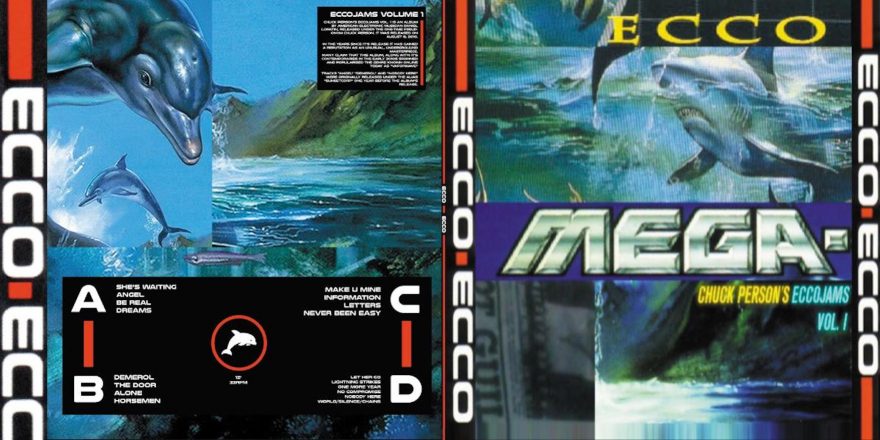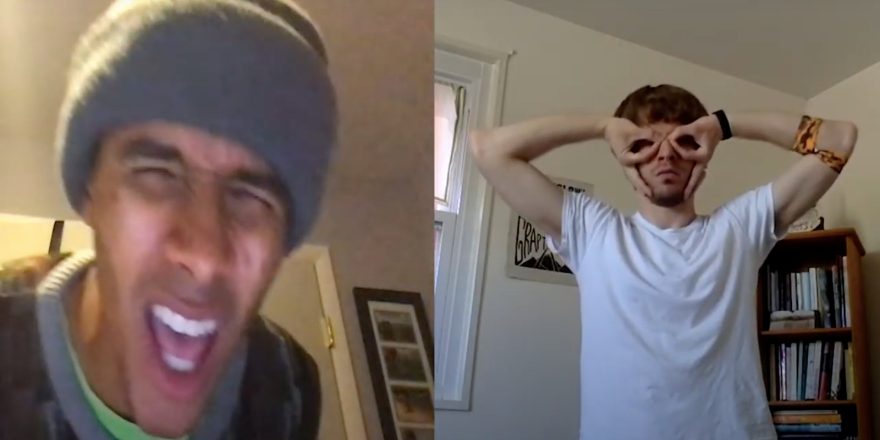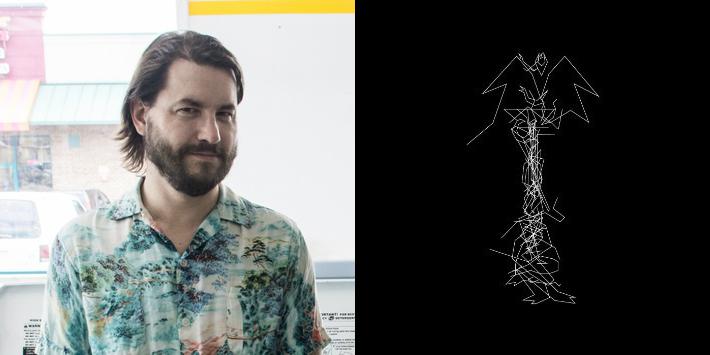Much like Ecco the Dolphin— the game from which the album’s title is taken — there is a sinister current pulsing through the glossy oceanic aesthetics of Brooklyn producer Daniel Lopatin’s now-10-year-old record Eccojams Vol. 1.
Much of Lopatin’s work — whether under the usual moniker Oneohtrix Point Never, or the one used here, Chuck Person — is in debt to Ecco the Dolphin. The frightening Sega Genesis game from the early ‘90s follows a bottlenose dolphin as he goes on a quest across time and space to save the ocean from H.R. Giger-esque aliens (yes, you read that right). Releasing a mixtape with the visuals of an aquatic adventure game under a moniker taken from an Indiana Pacers small forward seems an exceedingly bizarre thing to do, but it’s a prime example of Lopatin’s M.O. Through his art he manages to make a cohesive world out of the disparate images presented by society, as we all must do in our lives.
The sinister edge behind the glossy exterior employed by Ecco the Dolphin can certainly be felt here. Through his many stylistic changes, from ambience to freneticism, Lopatin has managed to maintain an almost anthropological view of pop culture expressed through his music. If one of the main intents of anthropology is to make what is readily familiar to us alien, and vice-versa, Lopatin’s Eccojams is a success. And from such a success sprung numerous imitators, not only within the vaporwave genre, but in every subsequent stylistic change Lopatin has made.
The style employed on Eccojams — released August 2010 — is the blueprint for vaporwave. Warped pop hooks awash in delay, reverb, and analog tape compression; looped, chopped, and shifted, often creating strange odd time grooves like a CD skipping through a pedal chain. It was this style, mixed with the early 2010s’ blogosphere staple “chillwave,” that created the classic vaporwave sound. But, unlike the warm, uncritical bright-eyed wistfulness of chillwave, Eccojams is an unnerving, often mournful piece of work that could inspire dread as much as nostalgia. “Be real, it doesn’t matter anyway,” a pitched-down loop sampling JoJo’s hit song “Too Little Too Late” repeats. The vocals and instrumental are dipped in sludge and echo back and forth against cavernous walls. The dense, compressed, overdubbed harmonies are immense and eerie. The bouncy delay creates a syncopated groove that surrounds the listener.
Standout tracks include “A2,” where Christine McVie plaintively moans, “angel, please don’t go,” as a harsh phaser warps and flattens Fleetwood Mac’s “Only Over You.” The sound is so massive, it strains against the tape compression. There are more abstract pieces like “A4,” where an inhuman sounding voice trades off with a cascading flute line. The lyrics “Demerol! Oh, god! He’s taking Demerol!” are sung with impassioned vocals that have been warped and muffled until it sounds like we, the listener are the “he” who has taken the opioid — and we’re witnessing someone’s horror at our state from our own intoxicated perspective. It’s a vision that’s darkness is conveyed without needing to know the nearly indecipherable lyrics. The sinister strings jab back and forth, robbed of their initial attack transients. A rubbery, overpowered flanger edges in, eventually encompassing the entire sample progression. For an album built upon spacious, ocean-sized ambience, Eccojams isn’t afraid to get gnarly. The album takes a turn for the punishing in “A8,” when a groovy R&B loop (the memorable “where’d you get that information frooooom?”) abruptly jumps into harsh noise. It’s a freaky palette to be sure. But, the paint sticks.
For the time, it was rare that a plunderphonics release employed use of pop samples with such a critical eye, especially compared to the doe-eyed yearning of Daft Punk’s Discovery or the juke box hero-worship of late era Girl Talk. This is to say, its use of samples is critical thematically, not production-wise. The production is relatively simple: The pitch of each song is pushed and pulled up and down through brittle “piano roll” style shifting. Throw on some hard slapback delay and even harder flanger, and that’s more or less it. As a teenager well-versed in the frenetic sample work of electro artists like Justice and the endlessly intricate production of Lopatin labelmates Squarepusher and Aphex Twin, I was rather miffed when I stumbled upon vaporwave releases employing this production style. Still, the immensely hypnotic sound, and the intent behind it, ended up winning me over.
I always found it ironic that vaporwave’s popular predecessor chillwave was declared dead almost as quickly as it received attention. Critics were so eager to christen, dissect, and eventually denounce the label that the fuss around the name almost seems irrelevant to the music itself. Are these critics, a decade later, surprised that chillwave acts like Toro y Moi, Washed Out, Com Truise, Tycho, and Neon Indian are still beloved artists continuing to release music? It reminds me of when Melody Maker released an article titled “Whatever Happened to Shoegazing?”… in 1992. This is where the stark divide shows itself between these “scenes.” Within vaporwave is imbued a conceptual framework: that capitalism is harmful and alienating, and vaporwave reflects this through the repurposing of pop culture (the samples, the vintage advertisements, etc.) You can listen with this context at the front of your mind. Chillwave is a genre which is more squarely defined by the sonic framework alone: LFO synths, reverb guitars, marriage of analog and digital production techniques. The lyrical themes vary more widely at the artist’s discretion.
So, the notion of cheap imitators that supposedly killed off chillwave actually rings more true in the vaporwave scene. Vaporwave’s relative ease of production, blatant ripping of already completed, copyrighted content made it so that there were numerous cheap knock-offs of Eccojams easily accessible on Youtube. The critical eye started to vanish, and the interesting tension between denouncing consumer culture and being drawn to it dissipated. A key example of this is the subgenre “future funk.” At its best, future funk is a continuation of early 2000’s French house with vaporwave aesthetics. At its worst, it’s poorly remixed, harshly compressed versions of perfectly awesome ‘70s and ‘80s disco.
But, is it fair to place the “anti-capitalist satire” distinction on all vaporwave, and to deny any piece not created with this intention? Is it undiscerning to look at all the pop songs sampled on Eccojams and dismiss them as tools of mass culture? I like the song “Woman in Chains”! I don’t think Tears for Fears is evil! There hardly needs to be a qualifier in order to enjoy “A3,” where a voice — floating somewhere between heavenly and demonic — croons to you from another dimension about “the castles in the sky.” Still, when an album’s sonic and visual template has an entire genre indebted to it, it is important to consider the critical eye with which the creator made it.
Future funk is more or less harmless fun that has the potential to introduce a young, Western audience to the rich and varied world of Japanese city pop, the genre from which so many samples are taken. What isn’t harmless, however, is the far right’s attempts to co-opt the sound and aesthetics of vaporwave through trends like “Fashwave” and “Trumpwave.” As the tropes of vaporwave were disseminated and diluted across internet culture and filtered into the mainstream, it became easier for extremists to co-opt them. This is where the distinction of legitimacy comes into play. It’s difficult to imagine early vaporwave classics like Eccojams, and James Ferraro’s Far Side Virtual being turned into fodder for white nationalist propaganda. The prospect of using these abrasive, unnerving albums to sell the youth on an authoritarian capitalist utopia doesn’t seem very promising. This is why the death of vaporwave was a much less arbitrary thing than a handful of early 2010s critics getting sick of describing chillwave as “summery.” The satire in vaporwave was diluted to almost non-existent. The genre, once critical of the fetishistic nature of capitalist lifestyle, turned into fetishism, and worse. The tension that Eccojams had — the bliss of nostalgia and the terror of the machine — was lost.
I’m not here to cry “phony!” at every random teenager who heard Eccojams and was inspired to rework some pop songs. Quite frankly, it sounds like I would be yelling at myself. I can’t denounce anyone for wanting to join in on the thrill of an internet movement, if their motives are benevolent. Lopatin himself has likened creating Eccojams to a folk art that others can participate in, creating their own. They most certainly did, creating works that run the gamut from memorable and meaningful, to disheartening and dangerous.
Vaporwave has had a strange life (and death). It can be infinitely dissected, read into, interacted with, for better or for worse. All of this can be said of Eccojams, its progenitor and paragon. It’s a smart, stirring release that had — and fulfilled — the potential to make waves culturally. At the turn of the millenium, the New York garage scene was starting a lo-fi revolution in rock that would cause a widespread aesthetic sea change. 10 years later, in the same city, did Lopatin know his lo-fi mixtape would start another revolution?







